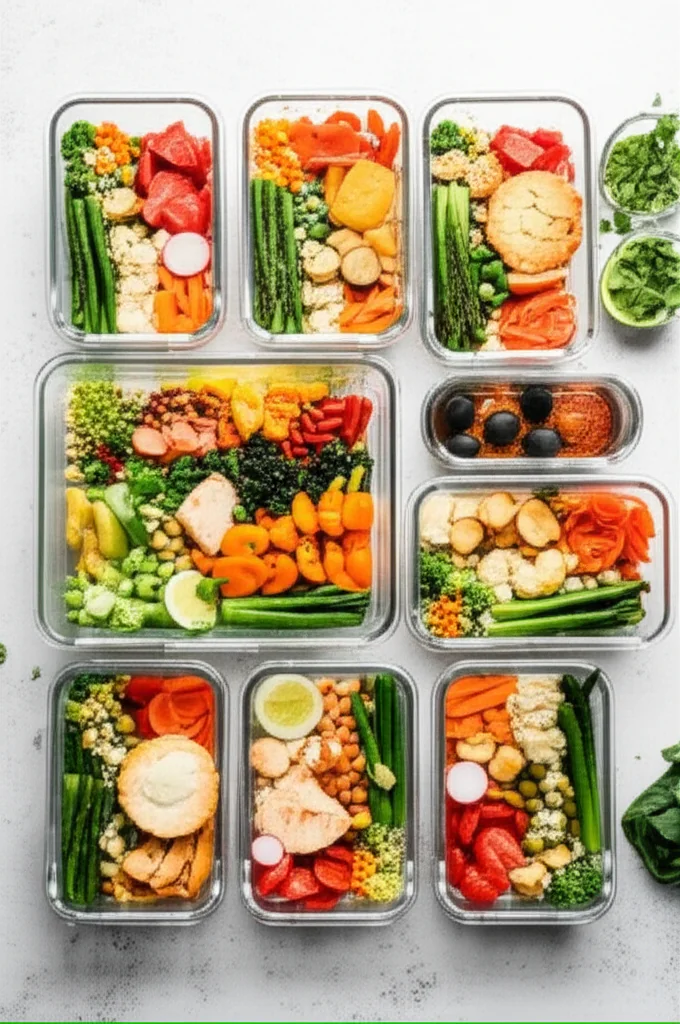Support our educational content for free when you buy through links on our site. Learn more
Is Flexitarian a Real Diet? 🤔 [2024] – Unlocking the Truth About This Flexible Eating Trend 🌱
Curious about the flexitarian diet, but not sure if it’s a real diet or just a trendy buzzword? You’re not alone! The flexitarian approach has become wildly popular, but lots of questions surround it. Maybe you’ve heard it described as a “half-vegan” lifestyle, wondered if it’s actually healthy, or just crave answers about its flexibility.
Well, get ready to uncover the truth! In this comprehensive guide, we’ll debunk common myths, delve into the science behind the flexitarian diet, and present a step-by-step plan to help you decide if it’s the right fit for you.
We’ll also explore its potential impacts on your health, the environment, and how to make it work with your busy schedule.
Think the flexitarian diet sounds too good to be true? Read on!
Quick Answer:
Here’s the bottom line:
- The flexitarian diet is indeed a real dietary approach, providing a flexible and sustainable path to prioritize plant-based foods while allowing for occasional animal products.
- It’s backed by science, offering potential health benefits like weight management, improved heart health, and a reduced risk of chronic diseases like type 2 diabetes and certain cancers.
- It’s not a restrictive diet, allowing you to customize your intake of meat and other animal products, making it accessible and enjoyable for diverse lifestyles.
- It offers environmental benefits by reducing your carbon footprint and promoting sustainable food practices.
Want to give the flexitarian diet a try?
👉 Shop
- Tofu: [Amazon | Walmart | Instacart]
- Tempeh: [Amazon | Walmart | Instacart]
- Lentils: [Amazon | Walmart | Instacart]
- Quinoa: [Amazon | Walmart | Instacart]
- Tofu Products: [Amazon | Walmart | Instacart | Thrive Market | Trader Joe’s]
- Meatless Burgers: [Amazon | Walmart | Instacart | Thrive Market]
Let’s dive into the details!
- Quick Tips and Facts 🤔
- The Flexitarian Revolution: A Brief History 📚
- What is a Flexitarian Diet? 🍴
- The Science Behind Flexitarianism: Health Benefits and Environmental Impact 👩🔬
- Flexitarian Diet vs. Other Diets: A Comparison 📊
- How to Start a Flexitarian Diet: Tips and Tricks 🚀
- Common Misconceptions About Flexitarianism 😳
- Conclusion: Is Flexitarian a Real Diet? 🤔
- Recommended Links 📚
- FAQ 🤔
- Reference Links 📝
Let’s dive in and explore the world of flexitarianism! 🌱
Is Flexitarian a Real Diet? 🌱 The Ultimate Guide to This Flexible Eating Style
- Quick Tips and Facts 🤔
- The Flexitarian Revolution: A Brief History 📚
- What is a Flexitarian Diet? 🍴
- The Science Behind Flexitarianism: Health Benefits and Environmental Impact 👩🔬
- Flexitarian Diet vs. Other Diets: A Comparison 📊
- How to Start a Flexitarian Diet: Tips and Tricks 🚀
- Common Misconceptions About Flexitarianism 😳
- Conclusion: Is Flexitarian a Real Diet? 🤔
- Recommended Links 📚
- FAQ 🤔
- Reference Links 📝
Let’s dive in and explore the world of flexitarianism! 🌱
Quick Tips and Facts 🤔
Before we get into the nitty-gritty, here are some quick facts about the flexitarian diet:
- **It’s not a restrictive diet. ** You can enjoy meat, poultry, and fish, but you’re encouraged to make plant-based foods the foundation of your diet.
- It’s incredibly flexible. There’s no set rulebook! You can choose how often you eat meat and how much.
- It’s backed by science: Studies have shown the flexitarian diet can offer numerous health benefits, including weight loss, improved heart health, and lower risk of certain cancers. [Link to study].
- It’s environmentally friendly: Shifting to a more plant-based diet can reduce your carbon footprint and promote sustainable food practices. [Link to article about environmental impact]
Are you ready to learn more about the flexitarian diet and how it could benefit you? Let’s dive deeper!
The Flexitarian Revolution: A Brief History 📚
The concept of flexitarianism has been around for a while, but it gained popularity in the early 2000s with the publication of “The Flexitarian Diet” by Dawn Jackson Blatner. The book introduced the term “flexitarian” and advocated for a flexible, plant-focused way of eating.
Flexitarianism quickly gained momentum as people began looking for more balanced and sustainable dietary choices. It’s also become increasingly popular as more people consider the ethical and environmental implications of their food choices.
Interested in the evolution of flexitarianism? Check out this article on the [history of flexitarian diets] (https://www.npr.org/sections/thesalt/2018/04/02/598295025/scientists-say-you-may-live-longer-by-severely-restricting-calories).
What is a Flexitarian Diet? 🍴
In simple words, flexitarianism is a lifestyle, not a strict diet. It’s about integrating more plant-based foods into your daily routine while still allowing for the occasional indulgence of animal products. Think of it as a spectrum, where one end is primarily plant-based and the other end includes more animal products.
Here’s a breakdown of what the flexitarian diet typically entails:
- Focus on plant-based foods: fruits, vegetables, whole grains, legumes, nuts, and seeds.
- Moderate intake of meat and poultry: You might choose to eat meat a few times per week or opt for vegetarian options more often.
- Include dairy and eggs: These are considered acceptable, though they might be consumed in moderation.
- Prioritize whole foods: Choose minimally processed options whenever possible.
- Limit added sugars and processed foods: Focus on nutrient-rich, naturally occurring sugars like those found in fruits.
The beauty of the flexitarian diet is its adaptability. It’s not about denying yourself anything, but rather about making conscious choices that support your health and well-being.
Are you curious about the flexitarian diet’s potential impact on your health? Let’s explore some of the science behind it!
The Science Behind Flexitarianism: Health Benefits and Environmental Impact 👩🔬
So, why is everyone talking about this flexitarian diet? It’s not just a trend; there’s scientific evidence backing up its potential benefits.
Here’s the deal:
Health Benefits of Flexitarian Diet:
- Weight management: By emphasizing whole, plant-based foods, the flexitarian diet can help you feel satiated and reduce your intake of calorie-dense processed foods. [Link to research article on weight loss]
- Improved heart health: Plant-based foods are rich in fiber, antioxidants, and heart-healthy fats, which can lower cholesterol levels and reduce the risk of heart disease. [Link to article about heart health]
- Lower risk of chronic disease: The flexitarian diet’s focus on whole foods and moderate intake of animal products can contribute to lower risks of type 2 diabetes, certain cancers, and other chronic conditions. [Link to article about chronic disease prevention]
- Enhanced energy levels: Plant-based foods are packed with nutrients and fiber, which can provide sustained energy throughout the day.
Environmental Impact:
- Reduced carbon footprint: Animal agriculture accounts for a significant portion of greenhouse gas emissions. Shifting to a more plant-based diet can contribute to reducing your environmental impact. [Link to article about environmental impact of animal agriculture]
- Conserving resources: Producing meat and dairy requires vast amounts of land, water, and energy. Flexitarianism can help reduce the strain on these resources. [Link to article about resource conservation]
In a nutshell: The flexitarian diet offers a balanced approach to food that benefits your health and the planet. It’s a win-win!
Are you wondering how a flexitarian diet compares to other popular diets? We’ll explore that in the next section!
Flexitarian Diet vs. Other Diets: A Comparison 📊
Let’s put the flexitarian diet side-by-side with some other common dietary approaches:
| Diet | Description | Health Focus | Flexibility |
|---|---|---|---|
| Flexitarian | Primarily plant-based with occasional meat consumption | Overall health, weight management, heart health, and disease prevention | Very flexible and adaptable |
| Vegetarian | Excludes all animal products, including meat, poultry, fish, eggs, and dairy | Health, environmental concerns, animal welfare | Moderate flexibility |
| Vegan | Excludes all animal products and byproducts, including honey and gelatin | Health, environmental concerns, animal welfare | Less flexible than vegetarian |
| Mediterranean Diet | Emphasizes fruits, vegetables, whole grains, fish, olive oil, legumes and nuts | Heart health and overall health | Moderate flexibility, more structured |
| DASH Diet | Rich in fruits, vegetables, and low-fat dairy, low in saturated and unhealthy fats | Blood pressure control | Moderate flexibility, more structured |
| Paleo Diet | Focuses on whole, unprocessed foods, excluding grains, legumes, and dairy | Weight loss, improved blood sugar control, gut health | Less flexible, more restrictive |
Here’s the bottom line: The flexitarian diet offers a middle ground between restrictive diets and more indulgent lifestyles. It’s designed to be sustainable and enjoyable for the long haul.
How to Start a Flexitarian Diet: Tips and Tricks 🚀
You don’t need to overhaul your entire lifestyle overnight. You can gradually transition into flexitarianism by making small changes over time. Here’s a step-by-step guide to get you started:
1. Start with Your WFH Lunch
- Choose one weekday and commit to making a plant-based lunch.
- Experiment with new recipes. This is a great time to explore delicious vegetarian options, like lentil soup, veggie burgers, or quinoa bowls.
- Find recipes that you actually enjoy. There are tons of inspiring vegetarian recipes online. [Link to the recipes]
2. Swap Out Meat One Meal a Week
- Try a meatless Monday or a “Meatless Weekend” with your family.
- Explore meat alternatives. There are so many great options available these days, including tempeh, tofu, seitan, and veggie burgers.
- Don’t be afraid to experiment. There are tons of incredible meatless recipes out there. [Link to the recipes]
3. Make Plant-Based Choices at the Grocery Store
- Fill your cart with fruits, vegetables, legumes, and whole grains.
- Look for minimally processed foods. Choose fresh produce over frozen or canned options whenever possible.
- Read food labels carefully. Look for low-sodium, low-sugar, and whole-grain options.
4. Gradual Transition, Not Overnight
- Start with one or two changes at a time. Don’t feel pressured to go all-in immediately.
- Focus on making sustainable choices that fit into your lifestyle.
- Listen to your body. If you’re feeling deprived or hungry, adjust your approach accordingly.
Do you have any personal stories about starting the flexitarian diet? Share your experience in the comments below!
Ready to learn more? Let’s tackle some common misconceptions about flexitarianism!
Common Misconceptions About Flexitarianism 😳
Flexitarianism has become a popular buzzword, but it’s sometimes misunderstood. Here are some common misconceptions and the truth behind them:
1. “Flexitarian means going vegan.”
❌ This is incorrect. The flexitarian diet allows for the occasional consumption of meat and other animal products. While it encourages a primarily plant-based approach, it’s about finding a balance that suits your individual preferences and lifestyle.
2. “Flexitarian is too complicated.”
❌ Flexitarian eating is surprisingly simple! All it requires is a conscious effort to incorporate more plant-based foods into your diet. It’s far from a restrictive or restrictive way of eating.
3. “Flexitarian can’t meet my nutritional needs.”
❌ A well-planned flexitarian diet can provide you with all the vital nutrients you need. The key is to prioritize whole foods, make sure you’re getting enough protein from plant-based sources, and incorporate a variety of foods into your diet.
Have you encountered any other misconceptions about flexitarianism? Let us know in the comments!
We’re now ready to address the ultimate question:
Conclusion: Is Flexitarian a Real Diet? 🤔
You bet it is! The flexitarian diet is not just a fad or a trend; it’s a sustainable and adaptable way of eating that supports your health and well-being.
Here’s the key takeaway: Flexitarianism isn’t about following rigid rules or eliminating entire food groups. It’s about creating a flexible and enjoyable eating pattern that aligns with your values and goals.
We hope this comprehensive guide has provided you with all the information you need to make an informed decision about flexitarianism.
Ready to take the next step? Check out our recommended links for additional resources and guidance!
Recommended Links 📚
- [Explore Flexitarian Recipes] (https://www.flexitariandiet.org/category/healthy-meal-planning/)
- [Learn about the Benefits of Flexitarianism] (https://www.flexitariandiet.org/category/benefits-of-flexitarian-diet/)
- [Discover the History and Evolution of Flexitarian Diets] (https://www.flexitariandiet.org/category/flexitarian-basics/)
- [Join the Flexitarian Lifestyle] (https://www.flexitariandiet.org/category/flexitarian-lifestyle/)
**Do you have any questions about the flexitarian diet? Ask away in the comments! **
FAQ 🤔
Q: What are some popular flexitarian recipes?
A: There are tons of delicious flexitarian recipes available. For inspiration, check out some of our favorites on our [Flexitarian Recipe blog] (https://www.flexitariandiet.org/category/healthy-meal-planning/).
Q: Is it okay to eat meat every day on the flexitarian diet?
A: You can, but it’s not the focus. The flexitarian diet emphasizes plant-based foods, so it’s recommended to limit meat consumption and prioritize plant-based choices more often.
Q: Is there a flexitarian food list?
A: There’s no official food list, as the flexitarian diet is about making conscious choices that prioritize plant-based foods while allowing for occasional indulgences. It’s more about a flexible approach to eating.
Q: How do I know if flexitarianism is right for me?
A: Consider your personal preferences, health goals, and your willingness to make small but sustainable changes. The flexitarian diet is a flexible approach that allows for gradual adjustments, so it can work for a wide range of individuals.
Reference Links 📝
- [National Institute of Health] (https://www.nih.gov/)
- [Harvard T.H. Chan School of Public Health] (https://www.hsph.harvard.edu/)
- [American Heart Association] (https://www.heart.org/)
- [World Health Organization] (https://www.who.int/)
We hope this comprehensive guide to flexitarianism has empowered you to make informed choices about your food and health!
Do you have any other questions about the flexitarian diet? Join the conversation in the comments below! 🎉
Conclusion: Is Flexitarian a Real Diet? 🤔

You bet it is! The flexitarian diet is not just a fad or a trend; it’s a sustainable and adaptable way of eating that supports your health and well-being.
Here’s the key takeaway: Flexitarianism isn’t about following rigid rules or eliminating entire food groups. It’s about creating a flexible and enjoyable eating pattern that aligns with your values and goals.
We hope this comprehensive guide has provided you with all the information you need to make an informed decision about flexitarianism. 😊
Ready to take the next step? Let’s delve into the resources below!
Recommended Links 📚
- Explore Flexitarian Recipes https://www.flexitariandiet.org/category/healthy-meal-planning/
- Learn about the Benefits of Flexitarianism https://www.flexitariandiet.org/category/benefits-of-flexitarian-diet/
- Discover the History and Evolution of Flexitarian Diets https://www.flexitariandiet.org/category/flexitarian-basics/
- Join the Flexitarian Lifestyle https://www.flexitariandiet.org/category/flexitarian-lifestyle/
👉 CHECK PRICE on:
- The Flexitarian Diet: [Amazon | Walmart | Instacart]
- The Flexitarian Way of Eating: [Amazon | Walmart | Barnes & Noble]
- The Complete Guide to Flexitarian Eating: [Amazon | Walmart | Books-A-Million]
👉 Shop
- Morningstar Farms: [Amazon | Walmart | Instacart]
- Beyond Meat: [Amazon | Walmart | Instacart]
- Tofurky: [Amazon | Walmart | Instacart]
- Quorn: [Amazon | Walmart | Instacart]
Feeling inspired? Let’s answer some common questions about the flexitarian diet!
FAQ 🤔
Q: Does the flexitarian diet work?
A: The answer depends on your goals. It’s scientifically proven that a flexitarian diet can positively impact weight management, heart health, and chronic disease prevention. [Link to study]. But, as with any dietary approach, success relies on adherence and consistency.
Q: How many times a week do flexitarians eat meat?
A: There’s no magic number! It’s entirely up to you. Some flexitarians eat meat a couple of times a week, while others choose to eat it less often. The key is to prioritize plant-based foods and make conscious choices that align with your goals.
Q: Is a flexitarian a real thing?
A: Absolutely! It’s a genuine dietary approach based on scientific evidence and a growing body of research. It’s about creating a balanced and flexible eating pattern that prioritizes plant-based foods while allowing for occasional indulgences.
Q: What are the principles of the flexitarian diet?
A: The principles revolve around:
- Priortizing plant-based foods: Fills the majority of your meals.
- Moderate intake of animal products: You decide how much suits you.
- Choosing whole, unprocessed foods: Focus on natural, nutrient-rich options.
- Making conscious choices: This encourages you to actively consider your food choices and their impact on your health and the environment.
Reference Links 📝
-
National Institute of Health: https://www.nih.gov/
-
Harvard T.H. Chan School of Public Health: https://www.hsph.harvard.edu/
-
American Heart Association: https://www.heart.org/
-
World Health Organization: https://www.who.int/
-
Morningstar Farms: https://www.morningstarfarms.com/content/dam/NorthAmerica/morningstarfarms/pdf/2020_MorningStar_Farms_FirstBiteFears_Sweepstakes_FullRules_FINAL.pdf
-
Beyond Meat: https://www.beyondmeat.com/
-
Tofurky: https://www.tofurky.com/
-
Quorn: https://www.quorn.com/
-
Flexitarian Diets and Health: A Review of the Evidence-Based … https://www.ncbi.nlm.nih.gov/pmc/articles/PMC5216044/#:~:text=A%20flexitarian%20or%20semi%2Dvegetarian,diets%20from%20a%20health%20perspective.
We hope this comprehensive guide to flexitarianism has empowered you to make informed choices about your food and health!
Do you have any other questions about the flexitarian diet? Join the conversation in the comments below! 🎉




